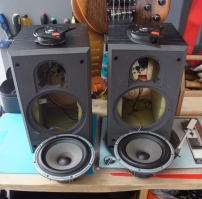It was quite a while ago now that I blogged about a pair of Bowers & Wilkins DM550 speakers that I’d found and bought on eBay (the blog post is here). After checking the speakers were working correctly, which, apart from a minor tweeter pair match issue, they were, my plan was to upgrade them with a few modifications and see how well they could be persuaded to perform. And then I got distracted for something like two and a half years.

In the last few weeks however I’ve pulled the pair of DM550s from under the desk where they’ve been resting and made the planned modifications. I replaced the electrolytic capacitors in the crossovers with metalised-polypropylene items of the same value, replaced the tired old connection terminals with new ones, short-circuited the tweeter fuses and, because it was so easy to do with the speakers disassembled, glued in place some vertical wooden bracing struts to the inside surfaces of the enclosure side panels. Such bracing will stiffen significantly the largest and potentially most resonant enclosure panel. I’ve included a bunch of photos showing the modification process underway. Click on the images to enlarge them in a new tab.

Firing up and listening to the newly refurbished DM550s left me in little doubt that not only was the DM550 in original form a very classy piece of 1980s electro-acoustic design (the crossover boards were stamped 1986), but that my modifications had added an extra sheen of precision and clarity to the subjective performance. Having said that however, such judgements are incredibly difficult to be certain of. Not only is the aural memory a capricious beast, but the same species of psychology that makes a car appear to run more smoothly following an afternoon spent cleaning it is likely to be at play. Having spent a day working on the DM550s, my brain was hardly going to allow me to imagine they sounded less good than before.

In objective terms, taking some quick FuzzMeasure data showed that the tweeter level had, as expected, risen very slightly thanks to the use of less “lossy” series capacitors, but no other changes were obvious. The decision to add the cabinet bracing was a spur of the moment one so unfortunately I had no opportunity to measure cabinet panel resonance before and after. Having said that, the braced cabinets sound very different, and far more solid, to a knuckle tap. I had hoped that changing the tweeter capacitors might improve the pair match issue that I discovered when I first measured the speakers, but that turned out not to be the case. The pair match issue looks to be inherent to the tweeters – it’s not a deal breaker however. The original measurement is here.

Despite the results of the modifications being difficult to discern through measurement, in my experience they will have almost certainly improved the speaker’s subjective performance to leave it even better suited to the nearfield monitor role.

Finally, while writing this post I made a quick eBay search to see if any similar pairs of DM550s happened to be looking for new homes. I didn’t find any DM550s, but this pair of DM560s (the ‘560 is slightly larger, reflex loaded version of the DM550) is promising, if maybe a little overpriced. They look a perfect subject I think for a DM550 inspired, “Monitoring On The Cheap” upgrade project.


your link to the Grammophone article leads to a “oops” page from them- might you send me a copy of the article?
i am looking at buying a pair of these B & W DM550s for $80,any advice?
LikeLike
Oh that’s sightly annoying on the Gramophone link front. It definitely used to work but they’ve clearly moved the document. Serves me right for not downloading it and linking to locally stored media. Thanks for letting me know anyway. I’ve updated the blog post…
As to what to look out for on a pair of DM550s – well nothing really. If they look like they’ve been well cared for then they should be fine. Maybe tap the cabinets with your knuckle and see if there’s any rattling sign of the front panels coming unglued from the wooden carcass (they can be easily re-glued). Also look closely at the tweeters to make sure the domes aren’t damaged (they’re really delicate and not that well protected). Finally, once you have the speakers up and running, they need a bit of boundary reinforcement so place them relatively close to a rear wall. they’ll sound a bit bass-light otherwise. If they’re in good condition you can’t really go wrong at $80.
LikeLike
What did they sell for new?
LikeLike